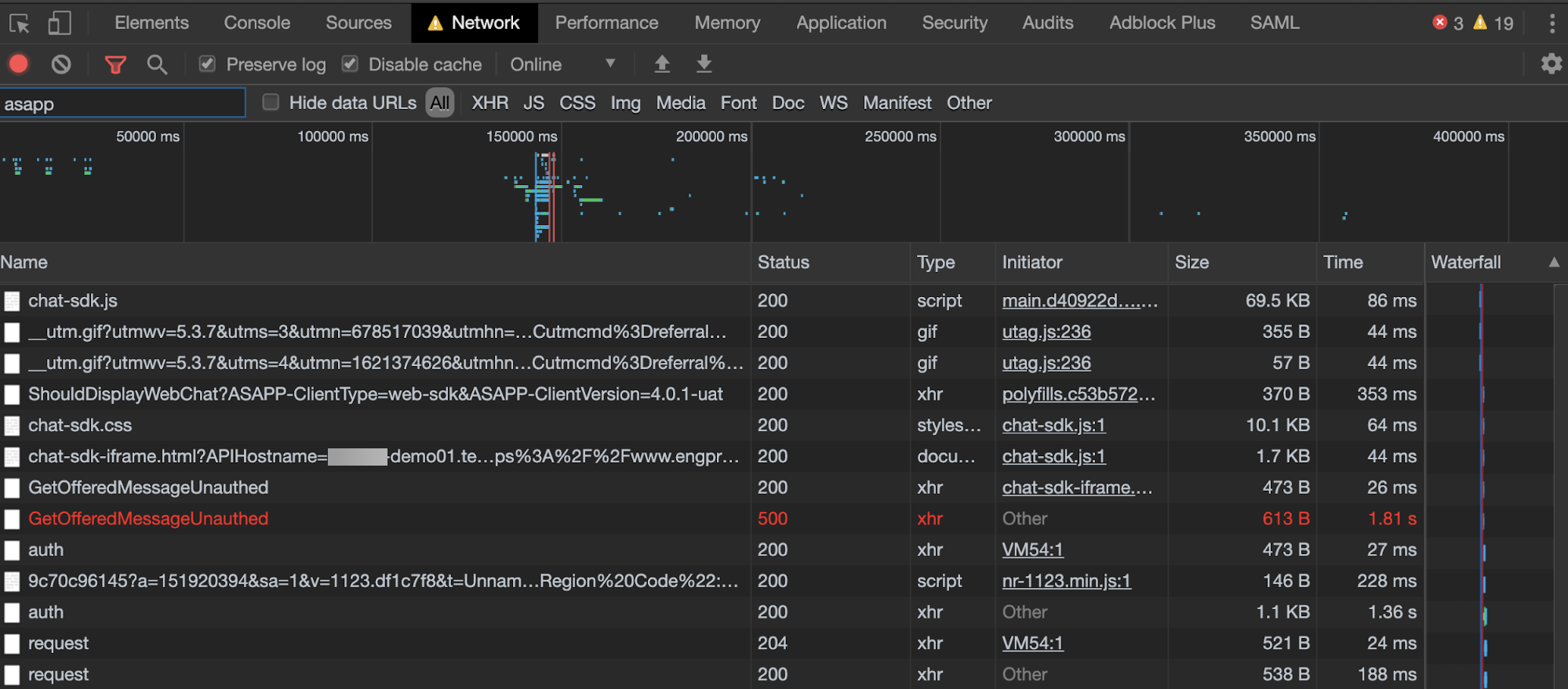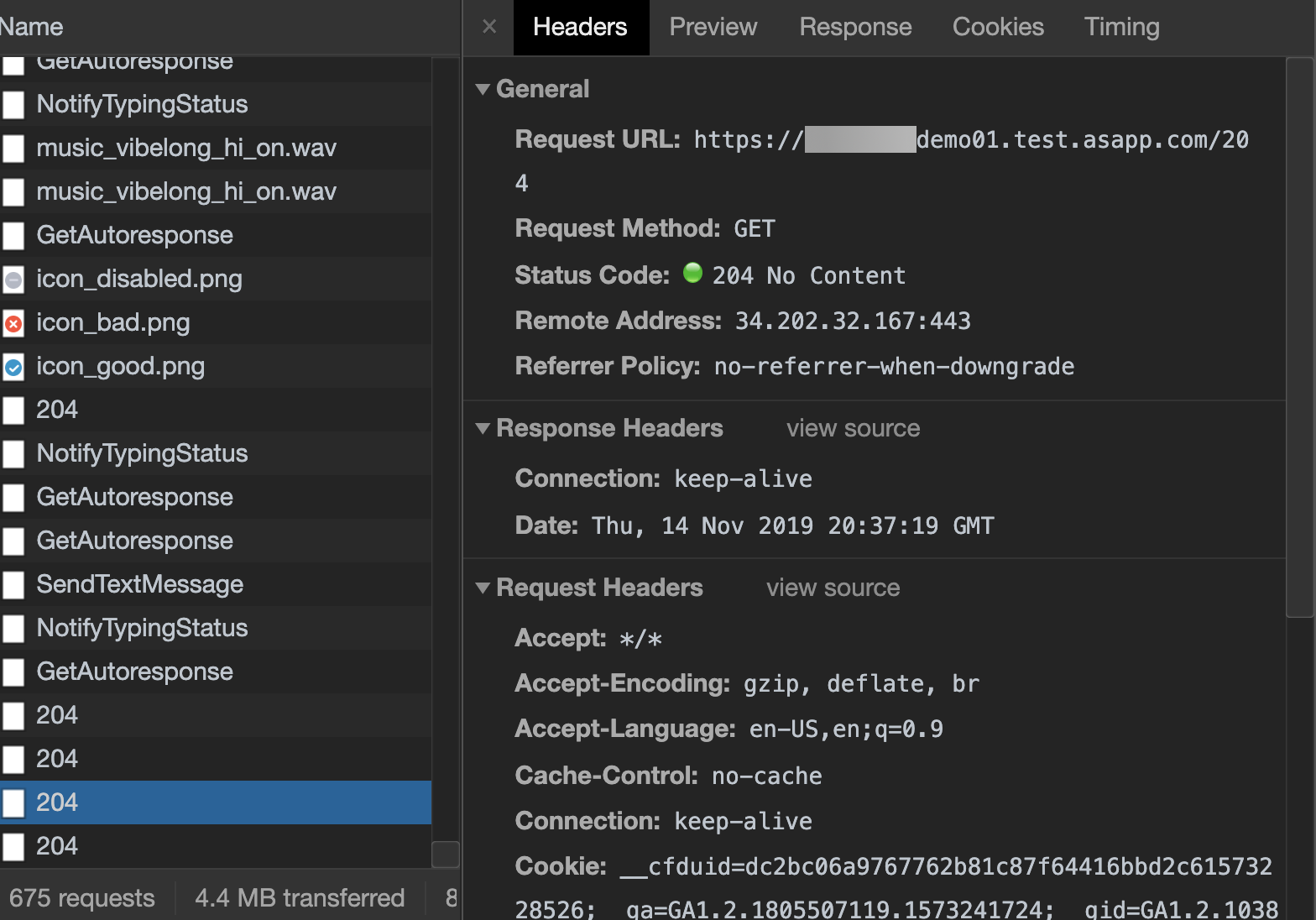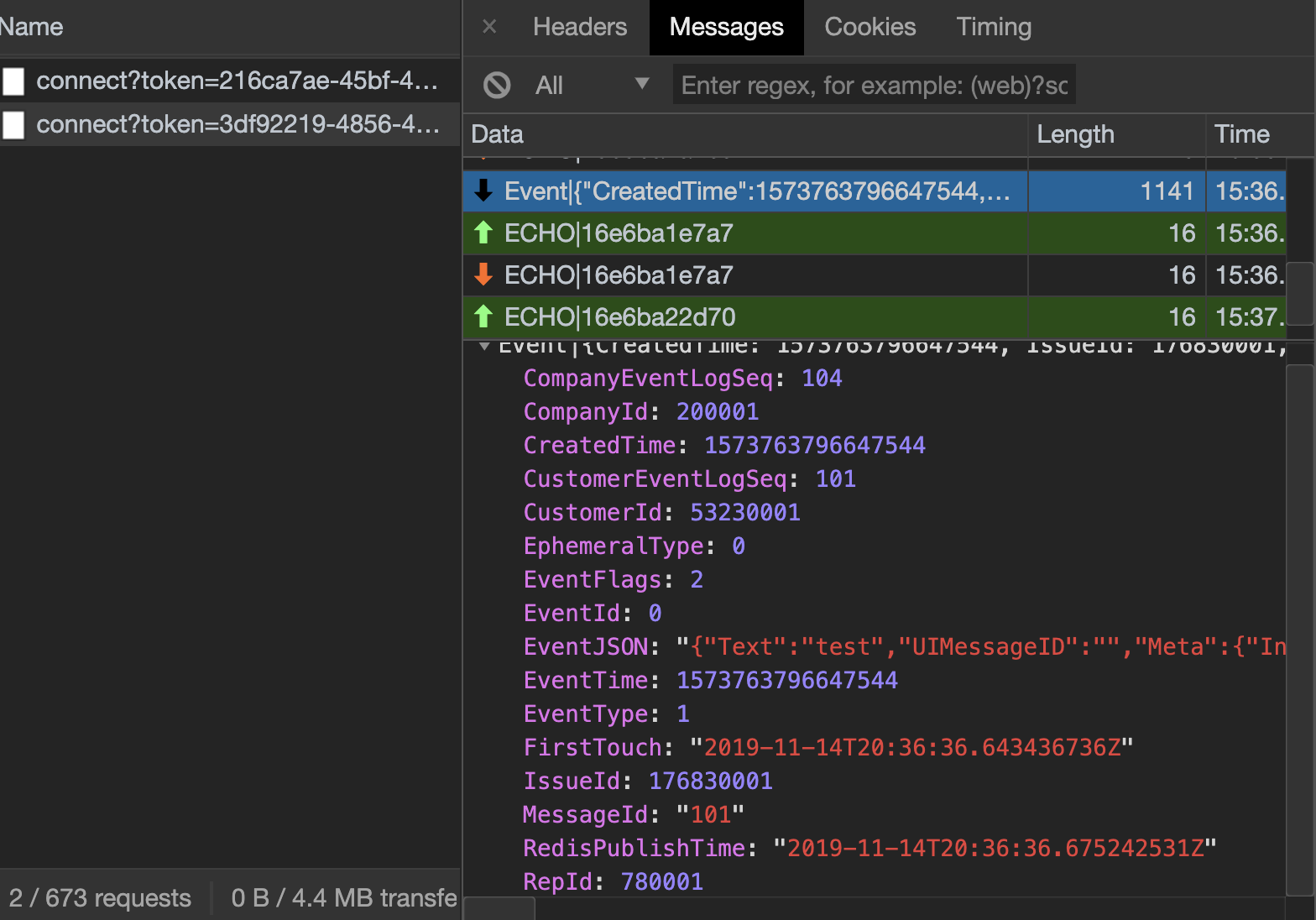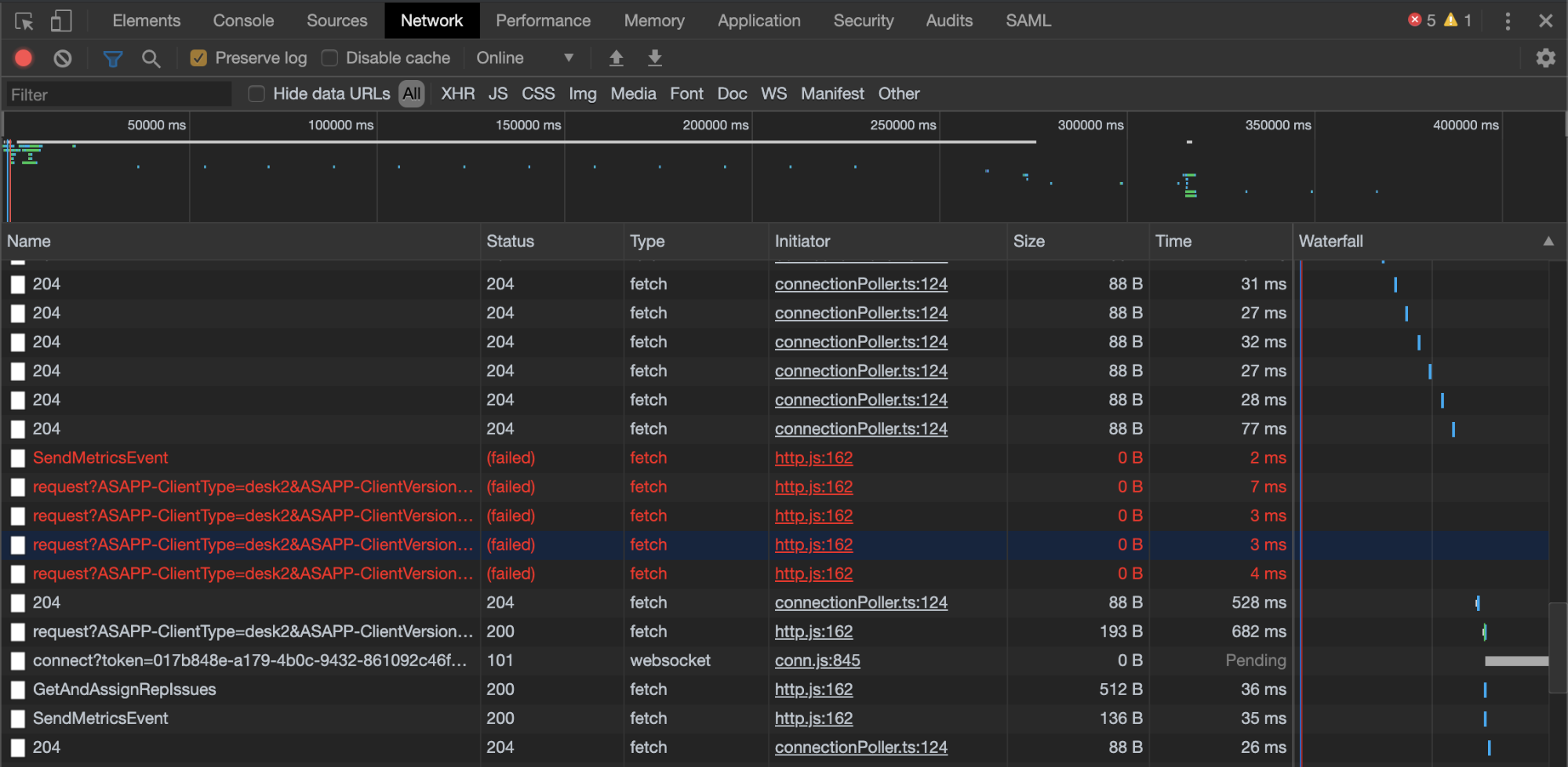You must have access to Chrome Developer Tools in order to use this guide.
Troubleshooting from a Web Browser
Using Chrome Developer Tools
Please take a moment to familiarize yourself with Chrome Developer Tools, if you are not already. ASAPP will base the troubleshooting efforts for front-end Web SDK use around the Chrome Web Browser. https://developers.google.com/web/tools/chrome-devtools/open ASAPP will also inspect network traffic as the Web SDK makes API calls to the ASAPP backend. Please also review the documentation on Chrome Developer Tools regarding networking. https://developers.google.com/web/tools/chrome-devtools/networkAPI Call HTTP Return Status Codes
In general, you can check connectivity and environment status by looking at the HTTP return codes from the API calls the ASAPP Web SDK makes to the ASAPP backend. You can accomplish this by limiting calls to ASAPP traffic in the Network tab. This will narrow the results to traffic that is using the string “ASAPP” somewhere in the call. First and foremost, look for traffic that does not return successful 200 HTTP status codes. If there are 400 and 500 level errors, there may be potential network connectivity or configuration issues between the user and ASAPP backend. Please review HTTP status codes at: https://www.restapitutorial.com/httpstatuscodes.html. To view HTTP return codes:- Open Dev Tools and navigate to the Network tab.
- Reload the page or navigate to a page with ASAPP chat enabled.
- Filter network traffic to ASAPP.
- Look at the “Status” for each call. Failed calls are highlighted in red.
- For non-200 status codes, denote what the call is by the “Request URL” and the return status. You can find other helpful information in context in the “Request Payload”.

Environment Targeting
To determine the ASAPP environment targeted by the front-end, you can look at the network traffic and note what hostname is referenced. For instance, …something-demo01.test.asapp.com is the demo environment for that implementation. You will see this on every call to the ASAPP backend and it may be helpful to filter the network traffic to “ASAPP”.- Open Dev Tools and navigate to the Network tab.
- Reload the page or navigate to a page with ASAPP chat enabled.
- Filter network traffic to ASAPP.
- Look at the “Request URL” for the network call.
- Parse the hostname from
https://something-demo01.test.asapp.com/api/noauth/ShouldDisplayWebChat?ASAPP-ClientType=web-sdk&ASAPP-ClientVersion=4.0.1-uat\: something-demo01.test.asapp.com

WebSocket Status
In addition to looking at the API calls, it is important to look at the WebSocket connections in use. You should also be able to inspect the frames within the WebSocket to ensure messages are received properly.
Troubleshooting Customer Chat
Should Display Web Chat
If chat does not display on the desired web page, the first place to check is ASAPP’s call forShouldDisplayWebChat via the Chrome Developer Tool Network tab. A successful API call response should contain a DisplayCustomerSupport field with a value of true. If this value is false for a page that should display chat, please reach out to the ASAPP Support Team. Superusers can access the Triggers section of ASAPP Admin. This will enable them to determine if the URL visited is set to display chat.
To troubleshoot:
- Open Dev Tools and navigate to the Network tab.
- Reload the page or navigate to a page with ASAPP chat enabled.
- Filter network traffic to ASAPP.
- Look at the “Request Payload” for
ShouldDisplayWebChatand look for atrueresponse forDisplayCustomerSupport.

Web SDK Context Input
To view the context provided to the SDK, you can look at the request payload of most SDK API calls. Context input may vary but typical items include:- Subdivisions
- Segments
- Customer info parameters
- External session IDs
Web SDK Context Provider
Review the ASAPP SDK Web Context Provider page
- Open Dev Tools and navigate to the Network tab.
- Reload page or navigate to a page with ASAPP chat enabled.
- Filter network traffic to ASAPP.
- Look at the “Request Payload” for
GetOfferedMessageUnauthedand open the tree as follows:

Customer Authentication Input
For authenticated customer chat sessions, you can see the Auth key within the context parameters used throughout the API calls to ASAPP. The values passed into the Auth context will depend on the integration.Web SDK Context Provider
Review the ASAPP SDK Web Context Provider page for the complete use of this key
Troubleshooting Agent Chat from Agent Desk
Connection Status Banners
There are 3 connection statuses:- Disconnected (Red)
- Reconnecting (Yellow)
- Connected (Green)
- 204 API calls
- WebSocket echo timeouts

204 API call
The ASAPP Agent Desk makes API calls to the backend periodically to ensure status and connectivity reporting is functional. Verify the HTTP status and response timing of these calls to look for indicators of an issue. These calls display as the number 204 in the Chrome Developer Tools Network tab. To view these calls:- Open Dev Tools and navigate to the Network tab.
- Reload page or navigate to a page with ASAPP chat enabled.
- Filter network traffic to ASAPP.
- Look at the “204” calls over time to determine good health.

WebSocket
When a customer chat loads onto the ASAPP Agent Desk, this creates a WebSocket. During the life of that conversation, ASAPP sends continual echoes (requests and responses) to determine WebSocket health and status. ASAPP sends the echoes every 16-18 seconds and has a 6 second timeout by default. If these requests and responses intermittently time out, there is likely a network issue between the Agent Desktop and the ASAPP Desk application. You can also view messages being sent through WebSocket, as the agent to customer conversation happens:- Open Dev Tools and navigate to the Network tab.
- Reload page or navigate to a page with ASAPP chat enabled.
- Click WS next to the Filter text box to filter network traffic to WebSocket.
- Look at the Messages tab in WebSocket.




Troubleshooting Agent Desk/Admin Access Issues
Using Employee List in ASAPP Admin
If a user has issues logging in to ASAPP, you can view their details within ASAPP Admin after their first successful login. Check the Enabled status, Roles, and Groups for the user to determine if there are any user level issues. ASAPP will reject the user’s login attempt if their account is disabled. To find an employee:- Login to ASAPP Admin.
- Navigate to Employee List.
- Use the filter to find the desired account.
- Check account attributes for: Enabled, Roles, and Groups.

Employee Roles Mismatch
During the user’s SSO login process, ASAPP receives a list of user roles via the Single-Sign-On SAML assertion. If the user roles in the Employee List is incorrect:- Check with your Identity & Access Management team to verify that the user has been added to the correct set of AD Security Groups.
- Once you have verified the user’s AD Security Groups, please ask the user to log out and log back in using the IDP-initiated SSO URL.
- If you still see a mismatch between the user’s AD Security Groups and the ASAPP Employee List, then please reach out to the ASAPP Support Team.
Errors During User Login
The SSO flow is a series of browser redirects in the following order:- Your SSO engine IDP-initiated URL — typically hosted within your domain. This is the URL that users must use to login.
- Your system’s authentication system — typically hosted within your domain. If the user is already authenticated, then it will immediately redirect the user back to your SSO engine URL. Otherwise, the user will be presented with the login page and prompted to enter their credentials.
- ASAPP’s SSO engine — hosted on the auth-{customerName}.asapp.com domain.
- ASAPP’s Agent/Admin app — hosted on the {customerName}.asapp.com domain.
- The SSO login URL being used by the user to login.
- The error page URL and error message displayed.